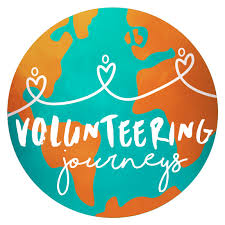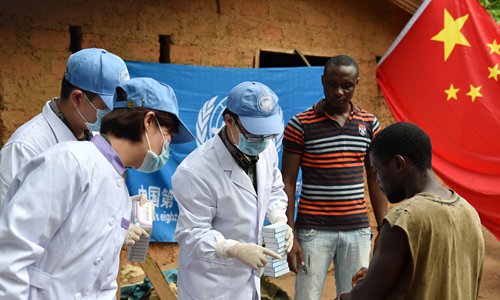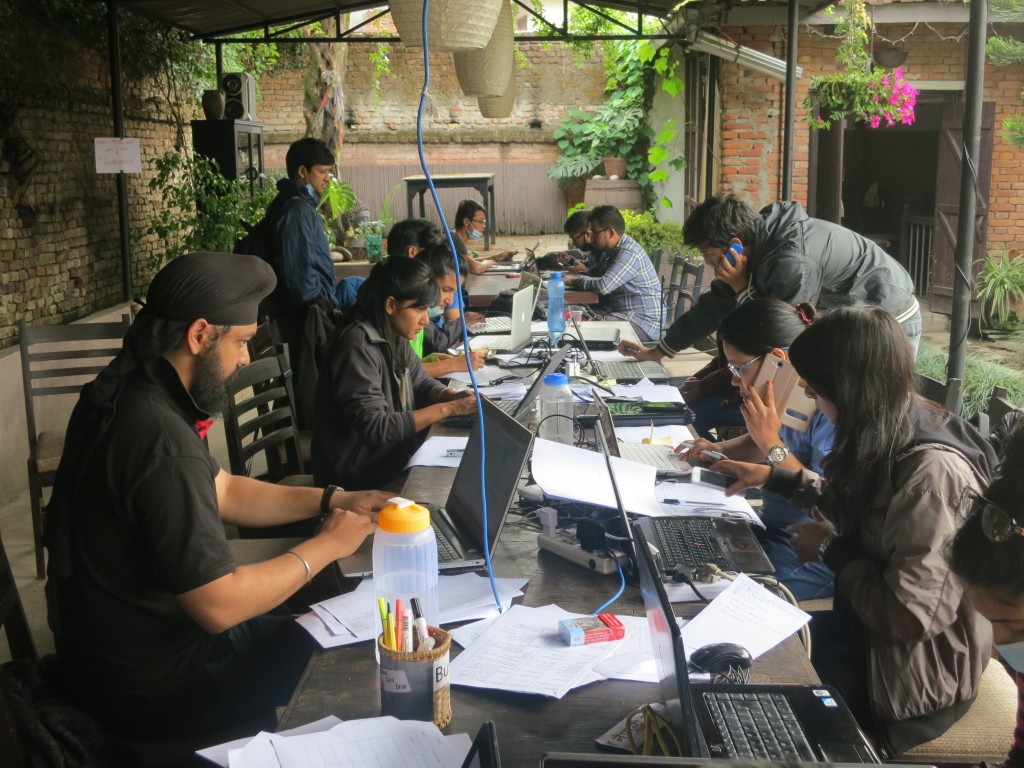Over the last two months, I have had the opportunity to embark myself on a fascinating journey and, taking advantage of my groupmates’ wise guide and advice, to discover the challenges and penuries that novice volunteers will encounter in their own journey. In this final blog, I will re-visit my previous contributions to our hands-on communication blog project, “A Better Volunteer”, and try to show my conclusions and reflections upon a topic of paramount importance for the humanitarian sector.

First stage: The humanitarian industry’s journey.
My first post was intended, despite the critical approach adopted, to highlight the steady but unstoppable transition that the development sector is experiencing at large, from post-colonial white-gaze to a new understanding of cooperation in which, South-South collaboration is taking up more room. Actually, the volunteering sector journey is manifold, and the on-board presence of countries such as China, India or Cuba has brought about a new course for the industry and contributed to giving voice to local initiatives which, at the end of the day, is the best recipe to facilitate the implementation of bottom-up projects and get rid of the ubiquitous white-saviour complex.

What is more, the current trend of promoting participatory approaches, in which the aid recipients are listened, needs to go a step further and avoid hypocrite attitudes where, showing apparently sympathy for the victims, the so-called us-ness ventriloquizes local voices and take the credit for the humanitarian outcomes, but without showing or accepting the Other as they really are (Hor 2017).
“A song sounds sweeter from the author’s mouth (Nigerien proverb).” (Ademolu et al. 2019)
Nevertheless, the perturbing stories of Cuban young doctors in Venezuela (Badcock 2019) or Chinese humanitarian workers during the Ebola outbreak in West Africa (Yanzhog 2017), involuntary volunteers in dire strait conditions, show how much politics matter in many allegedly humanitarian missions beyond moral implications. Regrettable enough, economic interests have a say in development affairs and, more often than not, after having escaped from their former colonial rulers, the liberated countries have simply swapped Western mastery by China’s dependency, which is perceived as a fellow developing country though (McEwan 2019, p.186) (Lumumba-Kasongo 2011).
Second stage: The journey along the sharp edge of molarity.
In contrast with the Cuban volunteers’ occasionally painful experiences, North young ‘voluntourists’ are supposed to enjoy their once-in-a-lifetime adventure that should quench the yearning urge for good-doing, closely related to their unspoiled capacity to feel empathetic emotions for the suffering others (Richey 2018). Needless to say, the longing for personal gratification through participation in fellow feeling missions can be easily distinguished in every vocational aid worker, some of them able to gift us with enlightening gems that embody the humanitarian quintessence…
“Put people at the core of what you’re doing. Sometimes there are a lot of things that would distract you but I always go back to the reason why I’m doing this work – it is the communities we work with. Listen to them because they are the only reason why we are here in the first place. They give meaning to what I am doing (Arnold Salvador).” (Ong et al. 2017)
But how to preserve the sector’s crown jewel, I mean the volunteers’ innocence, when money is big in the industry and there is so much at stake? Who is entitled to sacrifice their humanitarian principles for the greater good of a noble cause? This ethical fold of the volunteering journey has been addressed in my second article focusing on some debatable policies in an industry which has grown into a lucrative business (Denskuns 2011), as young altruistic workers are arriving in droves, and is dangerously flirting with the same practices that they were supposed to reverse. Consequently, the voluntary sector is usually seen as a private activity regardless of its alleged not-for-profit intentions that are characteristic of civil society (Unwin 2017, p.25).

For this reason, the volunteers will find themselves at a crossroads, having to cope with a good deal of frustration while seeking to stand against practices which, paradoxically, they have been asked to take part in (Richey 2018). However, should the volunteer desire to stick to their values, there are simple recipes: sincere engagement with projects committed to the community’s long-term self-sustenance and of course, respect for the recipients’ dignity beyond their mere consent, taking into consideration the unintended repercussions of their actions (Lippincott 2020) and avoiding the white saviour unnecessary rituals (Denskuns 2019b).
Third stage: The digital journey.
And finally, my third and fourth posts have been dedicated to the evolution process that the volunteering sector, as a part of the humanitarian industry and society as a whole, is undergoing owing to a new scenario of quasi-universal access to cutting-edge information and communication technologies (or ICTs).
Palpably, volunteering action has been made easier by online resources and even more, in difficult times after the Covid19 outbreak, when half of the global population is bound to be confined and travellers are stigmatized as vectors of the pandemic. Notwithstanding the evident limitations, technology has given rise to a new category of missions which can be joined by anybody with basic digital skills and has facilitated to become an online volunteer from any location or device.
“Anyone can be a digital humanitarian, absolutely no experience necessary; all you need is a big heart and access to the Internet (Patrick Meier)” (Shringarpure 2020)
Besides, ICT’s are part and parcel of most humanitarian actions, enabling the aid workers’ tasks and empowering individuals and communities to achieve freedom in a broad sense, from human wellbeing to participation in the political sphere (Kleine 2010), or to put it simple, allowing them to hold the reins of their own journey towards development.

However, regarding technological breakthroughs, there are swings and roundabouts, taking into account that on the one hand, ICTs may well facilitate and support the activities of humanitarian organizations and volunteers while promoting social advancement (Heeks 2017, p.270), but on the other, there is a tendency to parochial functionalism that puts the stress on tools and systems over a wider view of long-run development achievements (Bentley et al. 2019).
In fact, ICTs should be regarded as just a valuable instrument for development and avoid the overemphasis on the digital (Sein et al. 2019, p.11), taking into consideration that many times, the drive for economic growth has resulted in inequalities for disadvantaged individuals or marginalized groups without access to technology (Unwin 2017, p.28) in terms of availability, affordability and appropriate knowledge (Kleine 2010). Needless to say, a question arises concerning the current accent on ICT for development: Are we losing sight of the bigger picture?
Still, this is a section along the volunteering path which, in my view, deserves to be trodden twice…
Retracing the journey.
Thirty years ago, I walked the Way of Saint James for the first time. At this very time, I was young and impatient, and undertook the adventure in a competitive mood, without understanding that the most important thing was just to arrive, or even better, to arrive well, after having enjoyed values and jewels along the path of such an enterprise. Back then, the only important thing was to arrive, as soon as possible, without realizing the spiritual dimension that I, fortunately, discovered during my second try.
And precisely, that is to what the path of volunteering boils down, to be aware of what the foundations of humanitarian action are which, from a theoretic point of view, can be summarized by Vokes’ definition of the concept:
“The concept of humanitarianism, defined as the act of providing assistance to ‘distant others’, with whom one has no personal connections…” (Vokes 2017, p.67)
Thus, the volunteering journey needs to be walked without missing two fundamental aspects, (1) the missions must be aimed at providing support and (2) the assistance should be given regardless of personal acquaintance with the people in need. Evidently, the second precondition falls perfectly into place with a world of possibilities opened up by new technologies, enabling volunteers to help the Other from distance which leads to the idea of digital humanitarianism (Shringarpure 2020). But what about the first prerequisite? What lies in the notion of assistance?
Assistance goes beyond economic support and, for this reason, many pitfalls in volunteering missions stem from an excessive focus on the survival of the project or even the sponsor’s interest which, instead of promoting long-term social equity within the favoured community and measures aimed at achieving self-dependency (O`Donnell 2019), frequently ends up in a humanitarian parody known as ‘voluntourism’ that has been pinpointed as a target of humanitarian humour (Schwarz et al. 2019).
In addition, even when the digital has become a crucial ingredient of the humanitarian work (Shringarpure 2020) and helped highlight long-lasting structural imbalances (Denskuns 2019a), ICTs have failed to reverse adverse structural weaknesses (Murphy et al. 2015, p.44) which calls into question their contribution to social advancement. Regarding this, I prefer to think of Development in a Digital World (Roberts 2019) when describing the current context in which volunteering missions are carried out, in lieu of other terms that give more prominence to ICTs at the expenses of central structural progress.
In brief, globalization and brand new technologies have allowed youth – but also young-spirited citizens – to enrol themselves in a broad range of volunteering missions worldwide. But beyond the satisfaction of participating in a humanitarian cause and living ‘the inside story’, the purpose of volunteering should stick to its ultimate goals, in other words, provision of assistance for communities in need and implementation of policies that really matter, attempting to make a difference in the recipients’ lives.
A final stage.
The volunteering journey may well be seen as just an initiatory key stage in the never-ending humanitarian work but which, due to its impact on the next generation of professional aid workers, must be viewed as pivotal for the future of the industry and consequently, treated with extreme care by decision-makers in the sector.
That said, volunteers should be coached by professionals with experience, not only in the performance of missions in the field but also, with sufficient capacity to transmit core humanitarian values and safeguard the principles of philanthropic action while inculcating respect for the recipients’ dignity. Obviously, basic training and apprenticeship must successfully cope with widespread problems such as ‘white saviourism’, ‘digital misrepresentations’ or ‘voluntourism’, avoiding contaminating the newcomers’ immaculate moral values by putting volunteers to the challenge of dodging the ethical perils in which, by no means, global humanitarian help can fall trapped.
From a different perspective, the current digital environment has become an invaluable resource for both online and onsite volunteers in their daily tasks, fostering participatory bottom-up processes and providing tools for public accountability which, at the end of the day, help empower communities and bridge the digital divide. However, technology itself rarely achieves either human progress or development goals which highlight the need for structural changes in the very heart of the communities. By the same token, volunteering must be understood through a lens of community action rather than technological implementation, avoiding the hype and hope of ICTs and following the Freirian idea that human advancement can only be achieved by raising social consciousness through constructive dialogue and education. Therefore, the volunteering journey must be guided along a path of grassroots active collaboration inside the community, allowing the volunteer to soak up the principles of fellow human solidarity which should firmly remain as the compass for every humanitarian career.
“The road points a direction. And a direction is much more than an outcome. (Jorge Bucay)”
To conclude, I cannot help but affirm that, as opposed to what might be thought beforehand, volunteering benefits, like any free giving action in life, are always greater for the participant in a mission than for the aid recipients, in view of the moral reward that volunteering involves… And that is where the essence of volunteering resides, in the selfless effort of those who, giving as much as they can, always receive far more than they have previously given.

And just remember, in most cases, for the would-be humanitarian worker, the best is yet to come.
Bibliography and references.
Ademolu, E. and Warrington, S. (2019) Who Gets to Talk About NGO Images of Global Poverty?, Photography and Culture, 12 (3), pp. 365-376. Retrieved October 31, 2020 from https://doi.org/10.1080/17514517.2019.1637184
Badcock, J. (2019). The hidden world of the doctors Cuba sends overseas. BBC News. Retrieved September 29, 2020 from https://www.bbc.com/news/uk-48214513.
Bentley, C.M., Nemer, D. and Vannini, S. (2019). “When words become unclear”: unmasking ICT through visual methodologies in participatory ICT4D. AI & Soc 34, pp. 477–493. Retrieved November 3, 2020 from https://doi.org/10.1007/s00146-017-0762-z
Denskuns, T. (2011). Adventures in Voluntourism-they have become part of tourism mainstream. Aidnography. Retrieved October 12, 2020, from https://aidnography.blogspot.com/2011/07/adventures-in-voluntourism-they-have.html
Denskuns, T. (2019a). Blogging and curating content as strategies to diversify discussions and communicate development differently. Aidnography. Retrieved November 7, 2020 from https://aidnography.blogspot.com/2019/12/blogging-curating-globaldev-content-diversify-communicate-development-differently.html
Denskuns, T. (2019b). White saviour communication rituals in 10 easy steps. Aidnography. Retrieved November 2, 2020 from https://aidnography.blogspot.com/2019/03/white-saviour-dooley-lammy-comic-relief-communication-rituals.html
Graham, M. (2019). Digital Economies at Global Margins. London: The MIT Press. Retrieved October 18, 2020 from https://www.idrc.ca/sites/default/files/sp/Images/idl-57429_2.pdf
Hor, A. (2017). Searching for Redemption: Distancing Narratives in the Everyday Emotional Lives of Aid Workers. ISA Annual Convention 2017. Retrieved November 2, 2020 from https://wpmu.mah.se/nmict181group2/files/2018/03/SearchingforRedemption-DistancingNarrativesintheEverydayEmotionalLivesofAidWorkers-24Mar2017.pdf
Heeks, R. (2017). Information and communication technology for development (ICT4D). London: Routledge. https://doi.org/10.4324/9781315652603
Kleine, D. (2010). ICT4What? – Using the Choice Framework to Operationalize the Capability Approach to Development. Journal of International Development, 22, pp. 674-692. Retrieved October 18, 2020 from https://core.ac.uk/download/pdf/28897018.pdf
Lippincott, B. (2020). Ethical Representation in Humanitarian Photography. Ethical Storytelling. November 2, 2020, from http://ethicalstorytelling.com/ethical-humanitarian-photography/
Lumumba-Kasongo, T. (2011) ‘China-Africa Relations: A Neo-Imperialism or a Neo-Colonialism? A Reflection*’, African & Asian Studies, 10(2/3), pp. 234–266. doi: 10.1163/156921011X587040.
McEwan, C. (2019), Postcolonialism, Decoloniality and Development, Oxford: Routledge.
Murphy, J.T. and Carmody, P. (2015). Africa’s Information Revolution: Technical Regimes and Production Networks in South Africa and Tanzania. Chichester, United Kingdom: Wiley.
Ong, J. C. and Combinido, P. (2017). The Filipino Aid Workers of Typhoon Yolanda: A Commemorative Feature. The Filipino Aid Workers of Typhoon Yolanda. 52. Retrieved November 2, 2020 from https://scholarworks.umass.edu/communication_faculty_pubs/52
Richey, L. A. (2018) Conceptualizing “Everyday Humanitarianism”: Ethics, Affects, and Practices of Contemporary Global Helping. New Political Science, 40 (4), pp. 625-639. Retrieved November 2, 2020 from https://doi.org/10.1080/07393148.2018.1528538
Sein, M. K., Thapa, D., Hatakka, M. and Sæbø, O. (2019) A holistic perspective on the theoretical foundations for ICT4D research, Information Technology for Development, 25 (1), pp. 7-25. Retrieved October 18, 2020 from https://doi.org/10.1080/02681102.2018.1503589
Shringarpure , B. (2020) Africa and the Digital Savior Complex, Journal of African Cultural Studies, 32 (2), pp. 178-194, Retrieved November 3, 2020 from https://doi.org/10.1080/13696815.2018.1555749
O`Donnell, S. (2019). The Psychology & Ethics of International Volunteering. Grassroots Volunteering. Retrieved October 11, 2020 from http://blog.grassrootsvolunteering.org/ethics-of-international-volunteering/
Roberts, A. (2019). Digital Development: What’s in a Name? Appropriating Technology. Retrieved October 12, 2020, from http://appropriatingtechnology.org/?q=node/302
Schwarz K.C, Richey L.A. (2019). Humanitarian humor, digilantism, and the dilemmas of representing volunteer tourism on social media. New Media & Society, 21(9), pp. 1928-1946. Retrieved November 6, 2020 from https://doi.org/10.1177%2F1461444819834509.
Unwin, T. (2017). Reclaiming Information and Communication Technologies for Development. Oxford: Oxford University Press. Retrieved 2 Nov. 2020, from https://oxford.universitypressscholarship.com/view/10.1093/oso/9780198795292.001.0001/oso-9780198795292.
Vokes, R. (2017). Media and Development, Florence: Routledge.
SAIH Norway (2013). Let’s save Africa! – Gone wrong. [Video]. YouTube. Retrieved November 6, 2020 from https://youtu.be/xbqA6o8_WC0
Yanzhog, H. (2017). China’s Response to the 2014 Ebola Outbreak in West Africa. Global Challenges. Wiley Online Lybrary, 2 (1). Retrieved September 29, 2020 from https://doi.org/10.1002/gch2.201600001.





